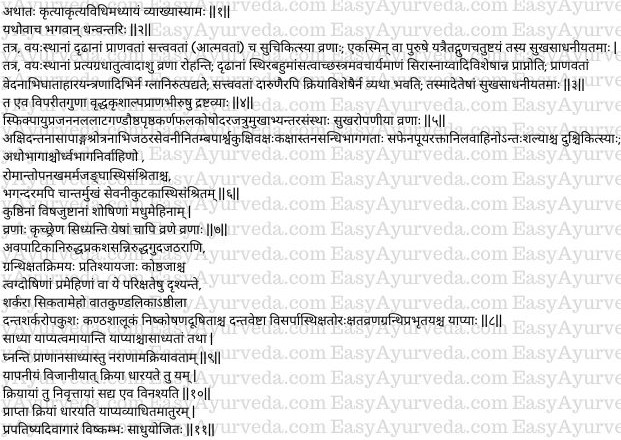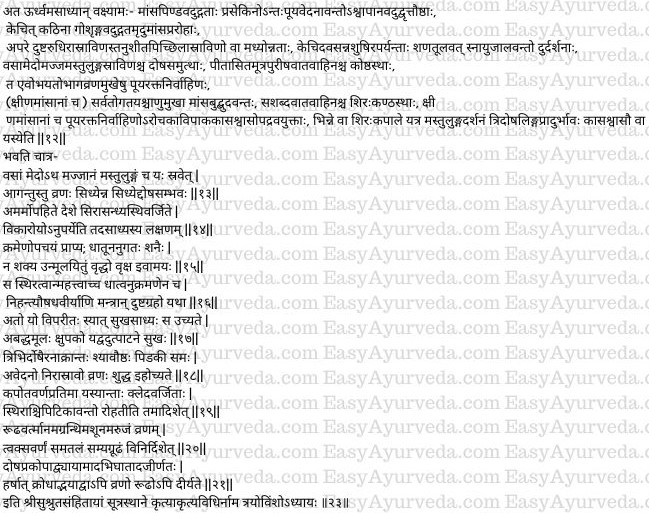This article explains Sushruta Samhita Sutrasthana Chapter 23 “Krutyakrutya Vidhi Adhyaya” – Curable and incurable wounds.
Krutyakrutya Vidhi

Curable and Incurable wounds
Now we will expound the chapter by name Krutyakrutya vidhi- curable and incurable wounds; as revealed by the venerable Dhanvantari.
Read – Lord Dhanwantari ‘The God of Ayurveda
Sukhasadhya Vrana
Easily curable wounds
Wounds are easily curable in persons –
- who are youths,
- strong,
- valiant (having strength to live),
- having strong mind (will power) and self-controlled
When all these four qualities are found in a single person, his / her wound is very easily curable.
In the youth, the wounds heal quickly because all the tissues are new and fully grown / have capacity to grow.
In a strong person, the body will have stable and well-developed muscles. The sharp instruments used in these people will not reach (cause damage) to the veins, tendons etc.
Persons who are valiant do not become exhausted by pain; injury (by instruments) and control (restrictions) over food etc.
Persons who are strong of mind (will power) do not suffer from pain caused by even greatly troublesome treatments.
Hence in these kinds of persons wounds are very easily curable.
It is opposite (not easily curable) in persons who are old, emaciated, not valiant, and afraid of life (death).
Wounds situated on the buttocks, rectum (anus), genital organ, forehead, cheeks, lips, back, ears, scrotum, abdomen, shoulders and inside of the mouth heal easily.
Read – Charaka Vrana Chikitsa – 25th Chapter – Wounds, Ulcers
Kricchra Sadhya vrana
Wounds curable with difficulty
Wounds situated in the eyes, teeth, nose, outer canthus of the eye, ears, umbilicus, sutures (raphae), buttocks, flanks, epigastrium, chest, axillae, breasts and joints; those which have sinus exuding froth, pus, blood and air (gas), which have a foreign body inside – are curable with difficulty. Similarly, those which eliminate (pus etc.) from below in the upward direction, those located near the border of the hairs (in the head), near the root of the nails, vital spots and bones of the foreleg; even (wound of) fistula-in-ano which is facing inward, that wound situated on the raphe and pelvic bone near it (coccyx) are difficult to cure.
Wounds in persons suffering from leprosy, poison, consumption, diabetes mellitus and in those who are having wounds already, heal with difficulty.
Yapya vrana
Wounds which persist long
Wounds produced by the below mentioned conditions are considered to be yapya (manageable / relievable but persisting for long, cannot be completely cured) –
- paraphimosis,
- phimosis,
- obstruction of the rectum (rectal stenosis) and
- enlargement of the abdomen;
- cystic swellings, injury (or injury of cystic swellings) and worms / worms developing in the wound over a tumor,
- worms appearing in nasal catarrh (rhinitis),
- worms appearing in the abdominal viscera / diseases of the abdominal viscera,
- worms found in the wounds / ulcers of (related to or caused by) skin diseases and diabetes
- sharkara meha and sikata meha (types of diabetes),
- vatakundalika – pain in the urinary bladder,
- ashtila – prostatic enlargement
- tartar of the teeth,
- gingivitis,
- tonsillitis,
- gums vitiated by harmful dentifrices, poisonous tooth pastes / powders,
- erysipelas,
- wound / tear of the bone,
- wound or tear of chest (lungs),
- tumor of wounds and such others
Importance of ‘timely and suitable treatment’ of wounds
In persons who do not take suitable treatments, curable wounds become relievable, relievable ones become incurable and incurable once destroys life.
Read – How To Make Prognosis Of Disease According To Ayurveda?
Yapya Vyakhya
Definition of yapya
Yapya (relievable) diseases are those which are under control by the help of treatment. But the same diseases would kill the person immediately (within a short time) after withdrawing /stopping the treatment. Relievable diseases sustain the patient when the treatment is available (as long as proper and timely treatment is in process) and kill him when the treatment is stopped, just like the house is supported by pillars properly placed (and collapse when they are removed).
Asadhya Vrana

Incurable wounds
Next, we will describe wounds which are incurable: –
Wounds presenting with the below mentioned features are considered to be incurable –
- wounds elevated like a ball of muscle,
- discharging copious exudation (pus, blood etc) in excess,
- which are filled with pus inside them
- associated with pain,
- lips (edges) of the wound are bulged out like the anus (anal opening) of a horse,
- some are hard, raised like the cow’s horn,
- some others have soft muscular sprouts protruding out,
- some wounds exude vitiated blood and some others discharge exudates which are thin, cold and slimy,
- those elevated at the center,
- some having their edges dipping inwards (into the wound) and cavities / perforations formed inside,
- some having network of ligaments which resemble beams (wick) of silk cotton and have ugly appearance,
- those which are produced by aggravated doshas (and due to the aggravation of doshas in them) and exuding muscle fat, fat, marrow and brain like matter
- wounds occurring in the alimentary tract from which there occurs yellow or black colored discharges or there is discharge of urine, feces or wind (fart / gas),
- the same (wounds of the alimentary tract) exuding pus and blood from their orifices at both ends i.e., from mouth and anal opening along with exudes from the wounds,
- wounds occurring in persons who have depletion of muscles and spread all over;
- those wounds having sinuses with minute orifices spread all over,
- those having bubbles (sprouts) of muscles,
- wounds situated in the head and throat bringing out air (gas) accompanied with sound,
- wounds in persons having emaciated muscles, exuding pus and blood,
- wounds associated (complicated with presence of) with loss of taste, indigestion, cough, dyspnoea and such other complications (secondary diseases),
- wound caused by fracture of the skull through which the brain matter is visible;
- wounds in which symptoms of all the three doshas develop,
- wounds associated or complicated by presence of cough and dyspnoea
Agantu Vrana
Agantu vrana (accidental / traumatic wound) which exudes muscle fat, fat, marrow and brain matter, might get cured but not that produced by aggravation of the dosas (also having exudes of muscle fat etc).
Read – Madhava Nidana Chapter 43 Sadyo Vrana Nidanam
Prognosis of wounds
The diseases (wound) which engulfs (vitiates and destroys all the tissues) even in a place which is not a vital spot and is devoid of veins, joints, bones etc is an incurable feature, especially so if they are not responding to the treatment.
The diseases which grow steadily involving the Dhatus (tissues) one after the other slowly, are not possible to be cured just as an old (big) tree (grown slowly and steadily).
Similarly, the disease which is stable, greatly increased and invading all the tissues gradually, nullifies the potency of the medicines just like malevolent planets nullify the chanting of hymns (power of expiatory hymns).
The wound which has features opposite of the above is said to be easily curable, so also that which is not firmly rooted (is curable easily) just as a young plant which is easy to be pulled out.
Suddha Vrana
Clean wound
The wound with the below mentioned features is said to be a suddha vrana (clean / healing wound) –
- that which is not invaded / affected by the tridoshas,
- that whose lips (edges) are blue in color,
- that which has developed (small) eruptions (granulation tissues) which are even,
- that which is not associated with pain and exudation,
Read – Injury, Wound care Ayurvedic Remedies, Medicines
Rohati Vranam
Wound which is healing
That (wound) which has the color similar to that of a pigeon, which is devoid of pus etc. (moisture, exudation), stable, and having chipitaka – dry, white, soft flakes of skin adhering firmly is considered to be healing.
Rudha Vrana
Healed wound
The wound whose lips (edges) have healed, which does not have knots of muscles in it, which does not have swelling all round it, which is not associated with pain, has same color as that of the surrounding skin, and which has become even is considered as samyak rudha i.e., properly healed wound.
Reasons for healed wound to get torn
Even a healed wound becomes torn (cracked furthermore) by aggravation of the dosha, by indulgence in physical exercise, injury, indigestion and too much of joy, anger or fear.
Thus ends the twenty third chapter named Krtyakrtya vidhi in Sutra Sthana of Susrutha.

